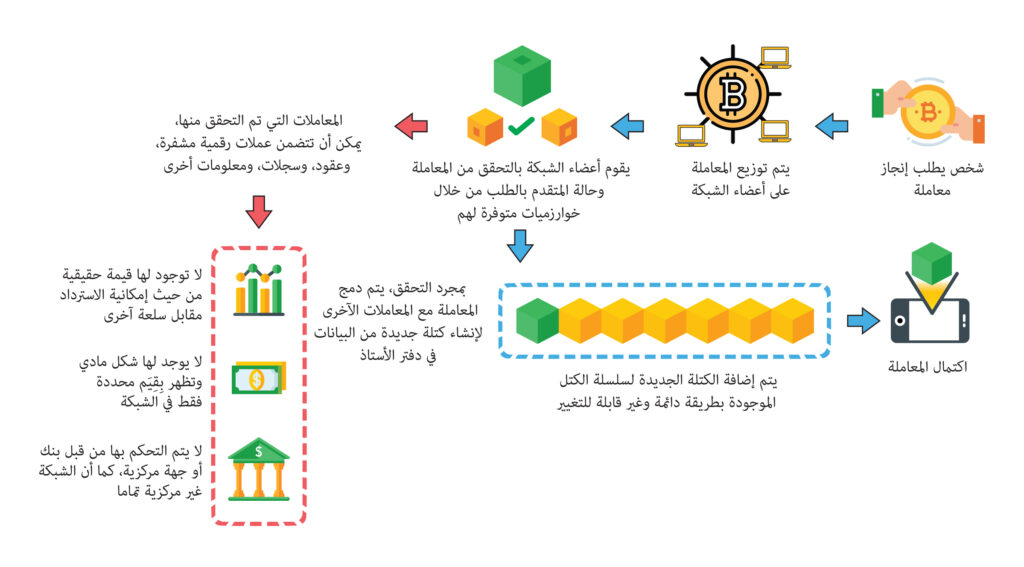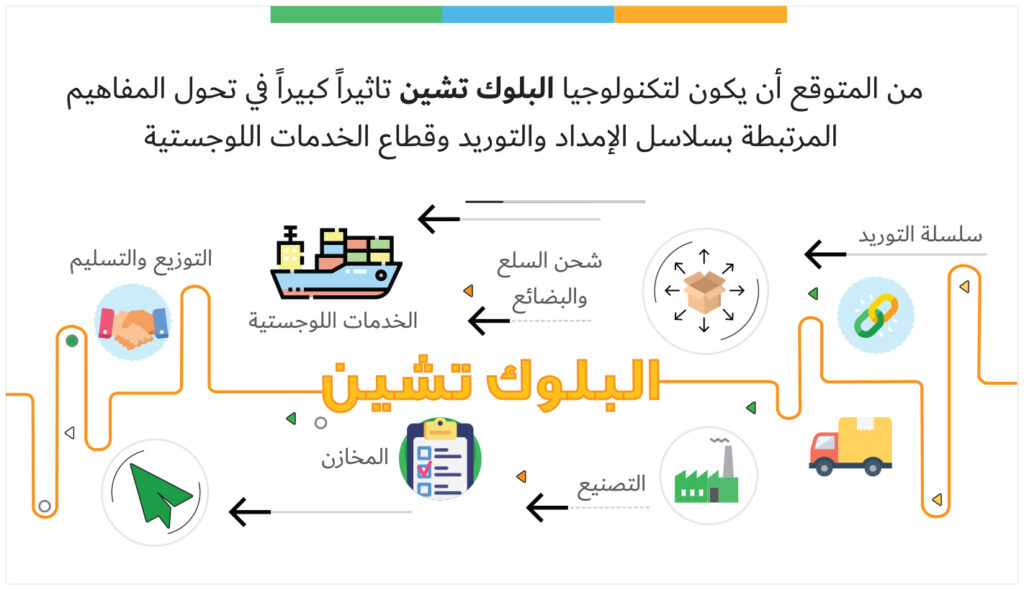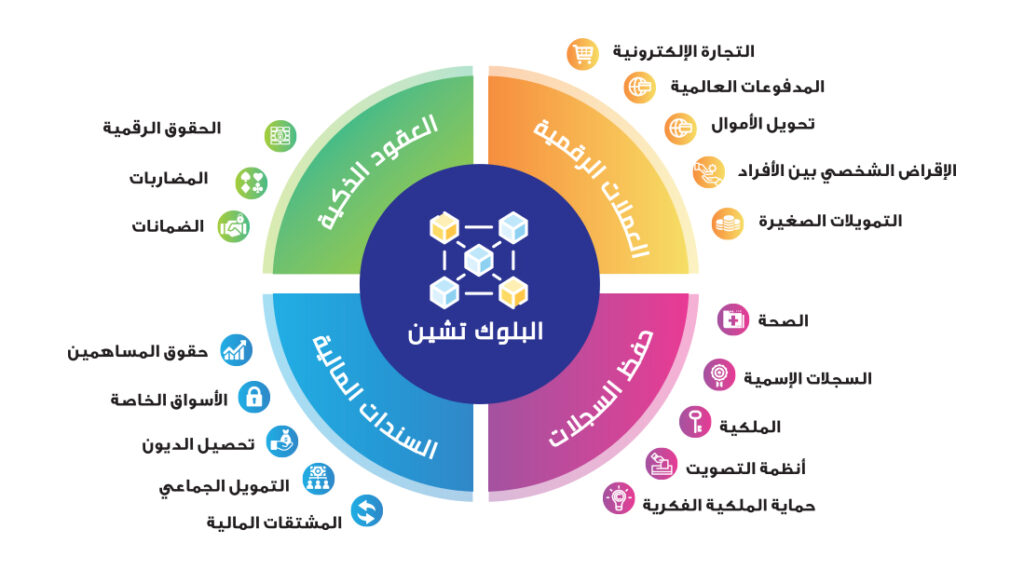
Share on:
In the previous episode, we mentioned that Blockchain technology promises to bring about revolutionary changes and a qualitative leap in the development of various sectors, as it presents a new concept in creating, organizing, proving and transferring data. In the second part of this episode on the topic, we will review the nature of the work of this technology so that we can later understand and imagine how it can be employed in our human and economic activities.
The Blockchain constitutes in its structure a decentralized digital record called a “ledger” that is available, distributed and documented among all the participants in the Blockchain network. And the ledger, in the language of financial practice, is the main and central record of accounting, in which all financial accounts of assets, revenues, expenses, gains and losses, and others are recorded.

The data of electronic transactions in the block chain is recorded accurately, efficiently, in a decentralized manner, and in a way that can be verifiably definitively and permanently. This technology also enables direct communication between the participants in the blockchain network to manage the chain, where the members – collectively and automatically, through the system – commit to a special protocol to communicate with each other (peer-to-peer), to create, add and modify the blocks and provide various mechanisms for verification It is valid and collectively approved.
Each block is issued with a unique, non-repeatable identification number, bears a digital fingerprint that includes the date of issue and is encrypted with highly complex encryption keys. In general, each block in this register holds the following main information:
That is, each block in the chain contains the data of the previous block and is considered a part of it, and includes interrelated information that links each block to each other, starting from its formation to the last update on it.
The security advantage of a blockchain is that once a block is registered and added in chronological order, the data for that block cannot be changed retroactively without changing all subsequent blocks, which requires the consensus of the majority of network members, which is part of the Practically impossible. This gives blockchain records the great advantage that they are not subject to change and tampering with data, due to the way they are decentralized.
The decentralized design of blockchains eliminates the need for a third party to process or store data, as it relies on the concept of Distributed Databases as opposed to a Centralized Database. It allows all the members participating in the chain to track all transactions on the network and access the ledger and browse its data.
By way of comparison with the current common approach in financial transactions, we find that most individuals resort to trusted intermediaries such as exchange centers and banks to complete financial transactions such as transferring and transferring money, while blockchain allows individuals and consumers to communicate directly with suppliers and service providers, which completely eliminates The need for third party and intermediaries. Also, blockchain transactions are characterized by the advantage of instant settlement that does not exceed a second or a few seconds to complete financial transactions, which some see that the impact of this may reach trillions of dollars annually, as a result of reducing intermediaries, reducing or no transaction fees, and a higher level of efficiency and effectiveness of systems. , other costs associated with infrastructure, etc.
As another comparison with the common approach in the field of central data storage systems, banks are responsible for the validity of financial data, including the value of customer balances, and it is a central responsibility as we know it to the bank only, and it must maintain its records in multiple ways to ensure the rights of depositors, but we are in block chains Chen, all customers’ data, including their financial balances, are distributed to all network subscribers.
In terms of security standards, if the bank’s data is compromised and changed by hackers, for example, they may directly access the central database – and electronic backup copies – and they will be able to change the data easily, assuming their ability to penetrate the security of the database, which is not impossible. Technically speaking. In contrast, on blockchain platforms, hackers will have to penetrate the devices of millions of users to modify the data of encrypted blocks, and in practice this is technically impossible, as it will be revealed before the data is changed.
Blockchain technology is expected to have a positive impact on supply chains, in its ability to trace products from farm seeds or raw materials to display shelves. IBM had announced a project in cooperation with the largest food suppliers to rely on blockchain to enable traceability of products within the food supply chain, and to provide transparency for consumers to know the true source of manufactured goods.


In the field of government work, a number of countries have announced the start of implementing projects based on blockchain technology for keeping digital records, such as registering and transferring land titles.
In the field of health care, blockchain applications would raise the levels of services provided and secure the confidentiality of medical records. And records in the blockchain would provide data to support the fight against viruses and diseases in our societies.
The expected impact of blockchain technology will bring about revolutionary changes in social and economic systems over the next two decades. It suffices that the simplest applications of this technology, such as encrypted digital currencies, have changed the rules of the game in financial services, whether they are linked to payment systems, the provision of loans, or the management of digital portfolios and others in the areas of digital inclusion. Also, switching to such technology will be of enormous economic cost because it will eliminate the need for intermediaries and third parties.

The adoption of this technology on data decentralization may restore confidence in digital systems, especially because it supports data confidentiality and information security. This decentralization will also open a new door of transparency to prevent data manipulation and corruption at the level of individuals, institutions and governments alike, and raise the level of trust in digital environments; That is, they build systems based on trust.
From this point of view, the applications of the Blockchain are promoted to enter the circle of political action, because by using them in voting systems, for example, it will never be possible to modify and falsify their data and results, which many believe that this technology would have prevented Russia from penetrating the voting systems in the presidential elections. America in 2016.
In summary, the impact of blockchain technology will be very profound in our societies, because it simply provides a revolutionary way of processing data and recording transactions in electronic environments, and advanced tools to verify and ensure the reliability of records in a way that cannot be tampered or changed, and that in itself will overturn economic systems and practices. In today’s world upside down!
| About | |
|---|---|
| Initiatives | |
| Knowledge | |
| Services | |
| Media Center | |
| Contact |